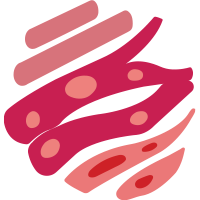
Muscle Cell News
Muscle Cell News is an online resource dedicated to the latest research into smooth, skeletal, and cardiac muscle cells.
Cardiomyocyte Mitochondrial Mono-ADP-Ribosylation Dictates Cardiac Tolerance to Sepsis by Configuring Bioenergetic Reserve in Male Mice
[Nature Communications] Researchers revealed that both genetic and pharmacological inhibition of mono-ADP-ribosyl hydrolase MacroD1 alleviates myocardial metabolic impairment, inflammation, dysfunction, and the risk of mortality caused by lipopolysaccharide and cecal ligation and puncture.
RPS27L Enhances Myogenesis and Muscle Mass by Targeting IGF1 Through Liquid-Liquid Phase Separation
[Advanced Science] Scientists observed that muscle-specific ribosomal protein S27-like (Rps27l) knock-in mice exhibit significantly increased muscle mass, enlarged myofiber size, a higher proportion of fast-twitch myofibers, and enhanced muscle regeneration capabilities compared to wild-type controls.
E2F5 Accelerates Vascular Smooth Muscle Cells Phenotype Switching in Diabetic Atherosclerosis through Activating Wnt/β-Catenin Pathway
[Diabetes & Metabolism Journal] Apolipoprotein E-knockout mice were intraperitoneally injected streptozotocin for five days and fed a high-fat diet for 12 weeks for establishing an in vivo diabetic atherosclerosis model.
Resistin-Like Molecule γ Attacks Cardiomyocyte Membranes and Promotes Ventricular Tachycardia
[Science] Using mouse models supported by human data, the authors determined that resistin-like molecule gamma is highly expressed in neutrophils after myocardial infarction.
Induced Somatic Mutation Accumulation during Skeletal Muscle Regeneration Reduces Muscle Strength
[Nature Aging] Researchers developed a mouse model in which genomic instability is induced specifically in muscle progenitor cells through targeted deletion of the Msh2 and Blm genes.
RyR1-Mediated Ca2+-Induced Ca2+ Release Plays a Negligible Role in Excitation-Contraction Coupling of Normal Skeletal Muscle
[Proceedings of The National Academy of Sciences of The United States of America] The authors created a mouse model carrying a mutation in the Ca2+-binding site in type 1 ryanodine receptor (RyR1), which selectively inhibits Ca2+-induced Ca2+ release.
Lactoferricin Enables Adenovirus Infection of Human Skeletal Muscle Cells
[Npj Viruses] Scientists assessed the ability of lactoferricin to enable HAdV-C5 infection and transduction of human skeletal muscle cells.
Excessive HIF-1α Driven by Phospholipid Metabolism Causes Septic Cardiomyopathy through Cytopathic Hypoxia
[Nature Cardiovascular Research] Researchers showed that upregulation of hypoxia-inducible factor-1α (HIF-1α) in cardiomyocytes following lipopolysaccharide treatment suppresses mitochondrial respiration via inducible nitric oxide synthase-dependent nitric oxide, leading to cytopathic hypoxia.
High Potency MyoAAV Capsids Enhanced Skeletal Muscle Correction in a Mouse Model of GSD IIIa
[Molecular Therapy-Methods & Clinical Development] To reduce effective vector dosages for transgene delivery to skeletal muscles, researchers packaged the AAV-Dual-Pull vector into two muscle-tropic MyoAAV capsids, MyoAAV4A and MyoAAV4E.
Distinct Specificity and Functions of PRC2 Subcomplexes in Human Stem Cells and Cardiac Differentiation
[Molecular Cell] Investigators showed that PRC2 subcomplexes have distinct roles in epigenetic repression of lineage-specific genes and stem cell differentiation.
Inhibition of Tenascin C Rescues Abnormally Reduced Na Currents in Dystrophin-Deficient Ventricular Cardiomyocytes
[American Journal of Physiology-Heart and Circulatory Physiology] The authors tested if tenascin C (TN-C) induces electrical remodeling in the dystrophic heart, and if inhibition of TN-C rescues peak peak sodium current loss in dystrophin-deficient ventricular cardiomyocytes.
REST/NRSF Preserves Muscle Stem Cell Identity by Repressing Alternate Cell Fate
[Nature Communications] Researchers showed that the master epigenetic regulator, Repressor Element 1-Silencing Transcription factor (REST) is a key regulator of non-muscle gene repression.
Every day, our editorial team sifts through the most recent scientific literature to help keep researchers and medical professionals current. Muscle Cell News covers the three types of muscle cells: cardiac, skeletal, and smooth muscle. We cover a broad range of topics, including cell culturing, muscle regeneration, and musculoskeletal disorders.

 Cancer Stem Cell News
Cancer Stem Cell News Cell Therapy News
Cell Therapy News Dermal Cell News
Dermal Cell News Endothelial Cell News
Endothelial Cell News ESC & iPSC News
ESC & iPSC News Extracellular Matrix News
Extracellular Matrix News Hematopoiesis News
Hematopoiesis News Hepatic Cell News
Hepatic Cell News Human Immunology News
Human Immunology News Immune Regulation News
Immune Regulation News
 Intestinal Cell News
Intestinal Cell News Mammary Cell News
Mammary Cell News Mesenchymal Cell News
Mesenchymal Cell News Muscle Cell News
Muscle Cell News Neural Cell News
Neural Cell News Organoid News
Organoid News Pancreatic Cell News
Pancreatic Cell News Prostate Cell News
Prostate Cell News Pulmonary Cell News
Pulmonary Cell News
